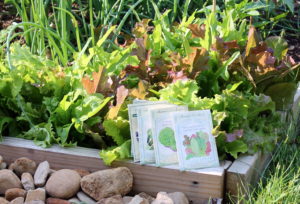The Great 2020 Seed Surge
June 16th, 2020
Two tenets of gardening that really fell out of favor in the last generation were growing vegetables and starting plants from seeds.

Seeds have been such a hot item this year that some catalog companies stopped taking orders for awhile.
Both were victims of convenience.
Why dig, sweat, lug, and get dirty trying to grow your own food when you can just go to the store and buy whatever you want?
And why try to decipher the mysteries of seed-starting when the greenhouses are full of ready-to-plant flowers to grab and go?
What a difference a pandemic makes.
Short on cash, stuck at home, and a bit stunned at the sight of empty grocery-store shelves, a lot of people suddenly realized this spring that maybe growing some of their own food and flowers isn’t such a bad idea after all.
Vegetable gardening is a particularly hot item again… seeds to grow them even more so.
Seed companies saw such a huge spike in sales this year that they ran out of varieties and couldn’t keep up with orders. Some mail-order seed companies fell so far behind that they stopped taking orders to catch up.
So if you didn’t get everything you wanted this year and found that it took your orders weeks instead of days to get to you, you weren’t alone.
Renee Shepherd, founder of one of my go-to seed companies, the California-based Renee’s Garden, said many companies got hammered with orders that were eight to 10 times the amount of a typical year.
She hasn’t seen anything like it in her 35 years in the home-garden seed business.
Vegetable and herb seeds accounted for most of the surge.
“Home garden favorites, such as tomatoes, squash, and cucumbers, have been especially in demand,” Shepherd says.
The “out-of-stock” notes that appeared on so many varieties this year didn’t result from a seed shortage, says Shepherd, but a seed supply problem.
“Seed companies like ours project by variety the numbers of seed packets home gardeners will want based on past experience and fill seed packets based on those projections,” she says.
When seed sales suddenly surged tenfold by mid-March, demand blew through the supply.
Compounding the problem was reduced workforce efficiency and way-longer-than-usual shipping times, since practically every industry was suddenly home-delivering just about everything.
“Our standard turn-around time to process, fill, and pack an order is within one day of receipt,” says Shepherd. “Once an order leaves our warehouse, delivery usually takes six to eight business days via UPS and USPS – except for this season!”
The 2020 order surge overwhelmed the small Renee’s Garden staff. Hiring extra staff was virtually impossible since “people have been understandably reluctant to enter into an unknown work situation,” Shepherd says.
She adds that social distancing meant fewer people working in each space, and the increased sanitation efforts stripped even more precious time from order-filling.
Once orders left the warehouse, the normal six- to eight-day UPS and USPS shipping times ballooned to 10 and even as long as 21 business days, Shepherd says.
Things are bouncing back to sane levels in recent weeks.
Seed racks are reasonably full in garden centers, and those “out-of-stock” notes are disappearing from the online catalogs.
Shipping still isn’t back to usual times, though, but at least more of the seeds are going out in the first place.
Seed companies are already stocking up for next year and planning for what could be the “new norm” – at least for a little while.
“We have adjusted our projections for 2021 and are filling many more packets,” says Shepherd.
She’s hoping that maybe once all the newbies get some growing experience under their belts, they’ll become lifelong gardeners – pandemic or not.
Even if this turns out to be a short-lived phenomenon, though, one thing is for sure… America’s yards are going to be sporting a lot more fresh produce this summer.
Either that or we’re going to see a lot of very fat groundhogs.
As for Renee’s Garden, its seed is sold by some 1,600 retailers throughout the United States as well as directly to home gardeners through the Renee’s Garden website.
I like the company’s offerings because it’s a nice blend of heirlooms and quality hybrids that Shepherd herself selects after trialing candidates from mostly small growers all over the world.
She shoots for the tastiest veggies, the best looks in flowers (many of them pollinator-friendly and good for cutting), and traits that set a variety apart from the norm.
She’s also a signer of the Safe Seed Pledge, which means no chemically treated and no genetically engineered seeds.
I especially like Renee’s custom salad-greens mixes, which are assorted combos of baby lettuces, arugula, mesclun, mustard, and such.
I’ve been cutting her ‘Cut and Come Again’ blend for weeks so far this spring. It’s almost too good-looking in the garden, though, to cut.
If you want to try three other of my Renee’s favorites, check out ‘Red Planet’ radishes (my new all-time radish top pick), ‘French Mascotte’ beans (a very heavy producer of slender and tender pods), and ‘Crispy Colors Duo’ kohlrabi (a mix of purple- and cream-colored kohlrabi varieties that are crunchy and mild).








